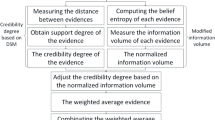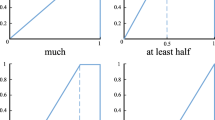Abstract
This paper presents a new method for sensor dynamic reliability evaluation based on evidence theory and intuitionistic fuzzy sets when the prior knowledge is unknown. The dynamic reliability of sensors is evaluated based on supporting degree between basic probability assignments (BPAs) provided by sensors. First, the concept of asymmetric supporting degree is proposed. By transforming BPAs to intuitionistic fuzzy sets, supporting degree between BPAs is calculated based on intuitionistic fuzzy operations and similarity measure. Then the relationship between dynamic reliability and supporting degree is analyzed. The process of dynamic reliability evaluation is proposed. Finally, the proposed dynamic reliability evaluation is applied to evidence combination. A new evidence combination rule is proposed based on evidence discounting operation and Dempster’s rule. Comparative analysis on the performance of the proposed reliability evaluation method and evidence combination rule is carried out based on numerical examples. The proposed method for data fusion is also applied in target recognition to show its feasibility and validity.

Similar content being viewed by others
References
Atanassov KT (1986) Intuitionistic fuzzy sets. Fuzzy Sets Syst 20(1):87–96
Atanassov KT (2012) On intuitionistic fuzzy sets theory. Springer-Verlag, Berlin
Atanassov KT, Gargov G (1989) Interval-valued intuitionistic fuzzy sets. Fuzzy Sets Syst 31(3):343–349
Baccour L, Alimi AM, John RI (2013) Similarity measures for intuitionistic fuzzy sets: State of the art. J Intell Fuzzy Syst 24(1):37–49
Bustince H, Burillo P (1996) Vague sets are intuitionistic fuzzy sets. Fuzzy Sets Syst 79(3):403–405
Dempster AP (1967) Upper and lower probabilities induced by a multiple valued mapping. Ann Math Stat 38:325–339
Deng Y, Shi W, Zhu Z, Liu Q (2004) Combining belief functions based on distance of evidence. Decis Support Syst 38:489–493
Elouedi Z, Mellouli K, Smets P (2004) Assessing sensor reliability for multisensor data fusion within the transferable belief model. IEEE Trans Syst Man Cybern B Cybern 34(4):782–787
Florea MC, Jousselme A-L, Bosse E (2009) Robust combination rules for evidence theory. Inf Fusion 10(2):183–197
Guo H, Shi W, Deng Y (2006) Evaluating sensor reliability in classification problems based on evidence theory. IEEE Trans Syst Man Cybern B Cybern 36(5):970–981
Jiang W, Xie C, Zhuang M, Shou Y, Tang Y (2016) Sensor data fusion with z-numbers and its application in fault diagnosis. Sensors 16:1509
Jousselme A-L, Grenier D, Bosse E (2001) A new distance between two bodies of evidence. Inf Fusion 2(2):91–101
Klein J, Colot O (2010) Automatic discounting rate computation using a dissent criterion. In: Proceedings of the Workshop on the Theory of Belief Functions, Brest, France, vol 2010, pp 1-6
Li G, Zhou Z, Hu C, Chang L, Zhou Z, Zhao F (2017) A new safety assessment model for complex system based on the conditional generalized minimum variance and the belief rule base. Saf Sci 93:108–120
Liu Z, Dezert J, Pan Q, Mercier G (2011) Combination of sources of evidence with different discounting factors based on a new dissimilarity measure. Decis Support Syst 52:133–141
Liu Z, Pan Q, Dezert J, Han J, He Y (2017) Classifier fusion with contextual reliability evaluation. IEEE Transactions on Cybernetics. https://doi.org/10.1109/TCYB.2017.2710205
Liu Z, Pan Q, Dezert J, Martin A Combination of classifiers with optimal weight based on evidential reasoning. IEEE Transactions on Fuzzy Systems. https://doi.org/10.1109/TFUZZ.2017.2718483
Rogova G, Nimier V (2004) Reliability in information fusion: Literature survey. In: Proc. 7th Int. Conf. Inf. Fusion, Stockholm, Sweden, vol 2004, pp 1158–1165
Schubert J (2011) Conflict management in Dempster–Shafer theory using the degree of falsity. Int J Approx Reason 52(3):449–460
Shafer G (1976) A Mathematical Theory of Evidence. Princeton University Press, Princeton
Smets P (2000) Data fusion in the transferable belief model. In: Proceedings of the 3rd International Conference on Information Fusion, Paris, France, pp PS21–PS33
Song Y, Wang X, Lei L, Xue A (2014) Combination of interval-valued belief structures based on intuitionistic fuzzy set. Knowl-Based Syst 67:61–70
Song Y, Wang X, Quan. W, Huang W (2017) A new approach to construct similarity measure for intuitionistic fuzzy sets. Soft Comput. https://doi.org/10.1007/s00500-017-2912-0
Song Y, Wang X, Lei L, Quan W, Huang W (2016) An evidential view of similarity measure for Atanassov’s intuitionistic fuzzy sets. Journal of intelligent & Fuzzy systems31, pp 1653–1668
Tang Y, Zhou D, Xu S, He Z (2017) A weighted belief entropy-based uncertainty measure for multi-sensor data fusion. Sensors 17:928
Wang X, Song Y (2017) Uncertainty measure in evidence theory with its applications. Appl. Intell. https://doi.org/10.1007/s10489-017-1024-y
Xu X, Li S, Song X, Wen C, Xu D (2016) The optimal design of industrial alarm systems based on evidence theory. Control Eng Pract 46:142–156
Xu X, Zhang Z, Xu D, Chen Y (2016) Interval-valued evidence updating with reliability and sensitivity analysis for fault diagnosis. Int J Comput Intell Syst 9(3):396–415
Xu X, Zheng J, Yang J, Xu D, Chen Y (2017) Data classification using evidence reasoning rule. Knowl-Based Syst 116:144–151
Yager RR (1992) On considerations of credibility of evidence. Int J Approx Reason 7(1):45–72
Yang Y, Han D, Han C (2013) Discounted combination of unreliable evidence using degree of disagreement. Int J Approx Reason 54:1197–1216
Zadeh LA (1965) Fuzzy sets. Inf Control 8:338–353
Zadeh LA (1986) A simple view of the Dempster–Shafer theory of evidence and its implication for the rule of combination. AI Magazine 2:85–90
Zhao F, Zhou Z, Hu C, Chang L, Zhou Z, Li G (2016) A new evidential reasoning-based method for online safety assessment of complex systems. IEEE Transactions on Systems, Man and Cybernetics: Systems. https://doi.org/10.1109/TSMC.2016.2630800
Zhou Z, Chang L, Hu C, Han X, Zhou Z (2016) A new BRB-ER-based model for assessing the lives of products using both failure data and expert knowledge. IEEE Trans Syst Man Cybern Syst 46(11):1529–1543
Zhou Z, Hu G, Zhang B, Hu C, Zhou Z, Qiao P (2017) A model for hidden behavior prediction of complex systems based on belief rule base and power set. IEEE Transactions on Systems Man & Cybernetics: Systems. https://doi.org/10.1109/TSMC.2017.2665880
Acknowledgments
This work was supported by the National Natural Science Foundation of China (Nos. 61703426, 61273275, 61573375, 61503407 and 60975026).
Author information
Authors and Affiliations
Corresponding author
Rights and permissions
About this article
Cite this article
Song, Y., Wang, X., Zhu, J. et al. Sensor dynamic reliability evaluation based on evidence theory and intuitionistic fuzzy sets. Appl Intell 48, 3950–3962 (2018). https://doi.org/10.1007/s10489-018-1188-0
Published:
Issue Date:
DOI: https://doi.org/10.1007/s10489-018-1188-0




